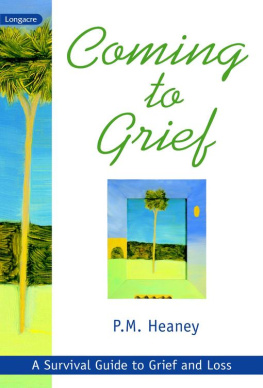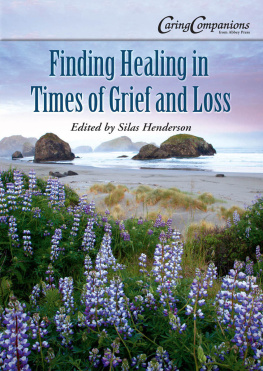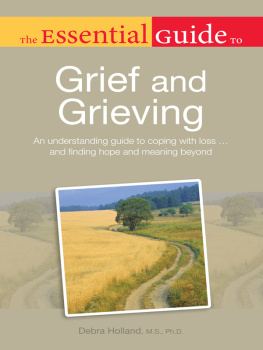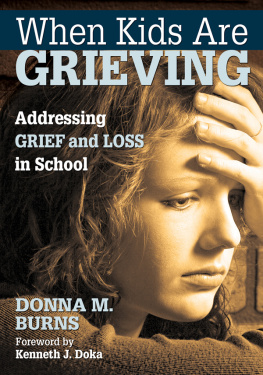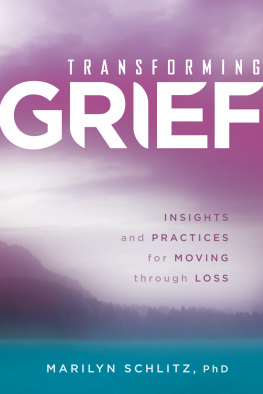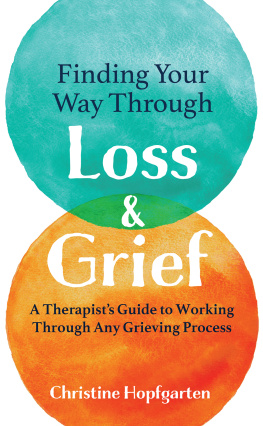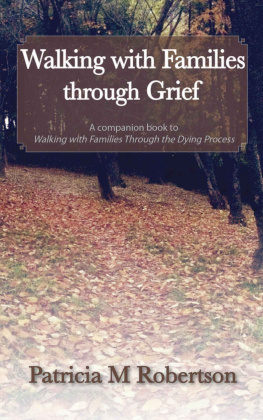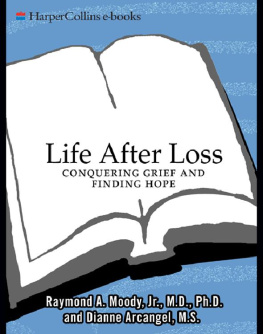W e experience grief and loss for many reasons: death, separation, divorce, redundancy, illness and through many other major life changes. Pam Heaneys thorough and perceptive exploration of grief is a book that will truly help us help ourselves and others.
Sensible, clear and caring in tone, the author explains how we express grief via our cultural and family conditioning, much of which is based on inadequate stereotypes and myths. In debunking the old cliches time heals all wounds, or you should be over it by now she offers insight into the true nature of grief and loss, and equips the reader with useful knowledge and understanding. She also provides strategies to help healing while recognising the unique grieving experience of each individual.
I n a way this all began when I was driving buses. Nearly twenty years ago now. At least, thats when I became acutely aware of death. Yet I suspect my learning about grief began long before then indeed when I look back I see that my whole life has been learning about how we grieve.
Twenty years ago, I was heading home one evening after completing the sight-seeing run. It was late, dark and cold; good enough reason to have fish and chips for tea. I was standing in the shop, having just given my order, when I heard an almighty thump from outside. An accident, I thought. Someone has hit something. Along with several others I rushed out to see what had happened. There was a body lying in the middle of the road.
I responded magnificently. Nobody could have wished for a better Manager of Operations. Come here, Go there, Ring for this, Ring for that, Stay with them, Look after those, Redirect here/there, Stop that. Brilliant!
Yet I became increasingly aware that I could not go anywhere near the man who was lying in the middle of the road. And I didnt understand why that was so. He was lying on his back, his arms and legs spread-eagled. His head was turned to one side and his eyes were closed. There was (to me) no visible sign of injury, and perhaps most surprisingly, there was no blood. So why couldnt I move forward and attend to him? After all, I had my St Johns Certificate and thought I was Superwoman so why was I unable to render first aid? I organised everyone and everything with gusto and remember feeling somewhat guilty as I stood there, unable to move. My feet felt nailed to the ground.
But what I had started to realise was that I did not know, could not tell, whether this man was alive or dead. I could not recognise dead. Here I was, 34 years of age, and I did not know what death was.
The ambulance arrived, the man was carried away, and the crowd began to disperse. I approached the ambulance personnel and asked whether the person was alive. I was dismissed with a curt response, something along the lines that such information could not be revealed, and who the hell was I to ask such a thing anyway? So now not only was I still ignorant, but I was also hurt at being so dismissed. It all added to the shock.
I went home and had my fish and chips. Very soon afterward I promptly lost them. I was in shock all right!
The question of whether the man had been alive or dead remained with me, and the realisation that I didnt know how to recognise death nagged at me constantly. I bought the papers until I read a brief report of the accident. Eyewitnesses reported seeing a man being struck by a car that threw him into the air and then into the path of another. The second was unable to stop, and it had run over him. He had died as the result of his injuries. I read his funeral notice.
Distressing as all this was, it still didnt tell me whether he had been dead or alive at the scene of the accident.
For the first time, I seriously began to think about life and death, and realised that death was something that would ultimately happen to me. I was still rather bemused by the fact that I couldnt recognise dead. Until one day the thought presented itself to me as If I dont know what dead is, maybe I dont know what alive is either.
This realisation provoked a serious line of thought. This was the start of my journey into grief. It was as if this single event had turned me upside down and shaken me apart. There began a process of looking at my own existence and deciding if I was truly alive. Did I pass each day in a monotonous routine that had little meaning or purpose? Was I living my life as I wanted to? Or was I always striving to make someone else happy and meet their expectations of me? Was I able to express myself creatively, spontaneously, and feel all there was to feel, be it joy, pleasure, sadness, rage or love? In short, the answers were yes, no, yes and no. At that point I decided I was therefore more dead than alive.
I then began the process of looking at life and death; and of looking at myself in relation to this. Those aspects of my life that are no longer appropriate I have discarded, those that are inadequate and damaged I am healing, and those that have been absent I am developing. The whole is being put back together in a new way that is an honest reflection of me and my desire to be fully alive. Now rather than deny, avoid or try to control difficult and painful issues I am learning to be self-aware, and to base my self-esteem and self-acceptance on personal responsibility (rather than on the management of crisis or by trying to be Superwoman).
My journey has taken me into Funeral Directing. I still find it ironic that I learnt so much about life and living by dealing with death and dying. It has led me to university, and to complete other studies to consolidate my practical experience. Along the way I have co-founded the Grief Education Trust, and helped initiate the National Association for Loss and Grief. I have conducted and promoted the importance of Critical Incident Stress Debriefing for people after traumatic events (such as the accident I witnessed), and I have worked with the dying and bereaved in an endless variety of situations. I have lectured in a wide range of tertiary institutions and directed educational programmes for health care professionals, volunteers, support groups, families and organisations. Through counselling, therapeutic workshops and grief recovery groups I have assisted people to move back into life after the dislocation of major loss.
I well remember when I had to ask myself why I was so passionately involved with grief, and to acknowledge just how much I enjoyed the work I was doing. My answer nowadays is the same as it was then. In giving others permission to grieve, I am in essence giving myself permission to do so as well. And I can now acknowledge that I had much in my life to grieve about. My study of grief continues, on both a personal and professional level.
There is also another dimension that fuels my ongoing involvement in this work. Grieving is something we all have to learn at some stage, but this learning process is not voluntary and is often not recognised in Western, Pakeha culture. Grieving is often resisted by many of us and the social norms that people have developed in order to cope have their foundation in myths. Consequently many people carry large amounts of long- standing unresolved grief. My experience has revealed that this affects their health, spiritual well-being and their ability to function, both at work and in relationships, in ways that are life-enhancing and which provide any degree of satisfaction. The personal and social costs of this unresolved grief are enormous, but again largely not understood.

